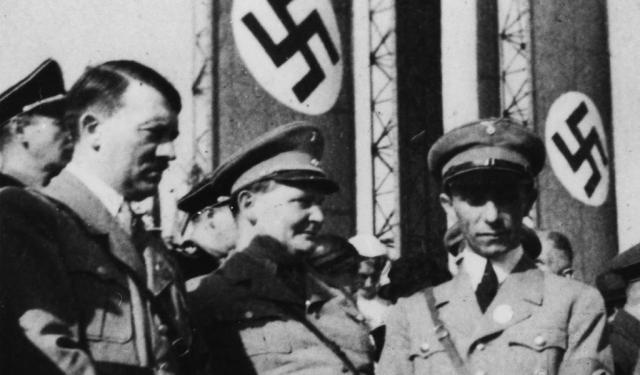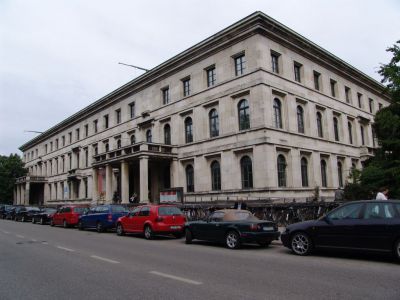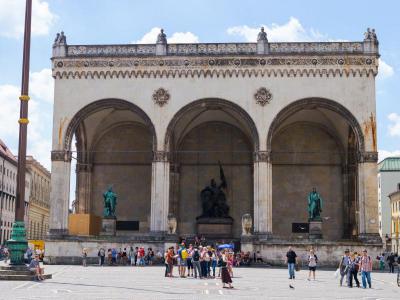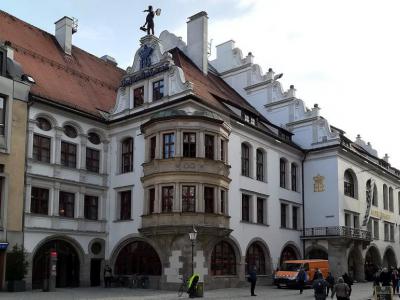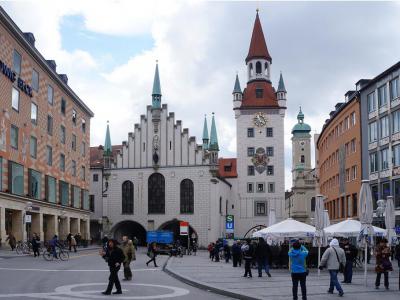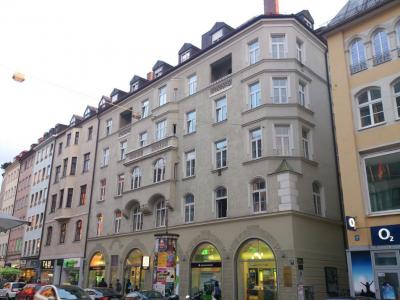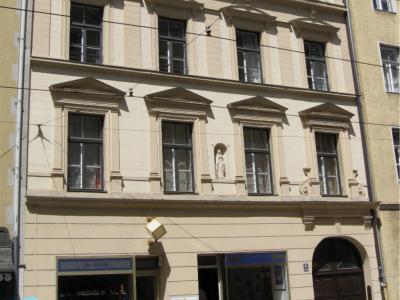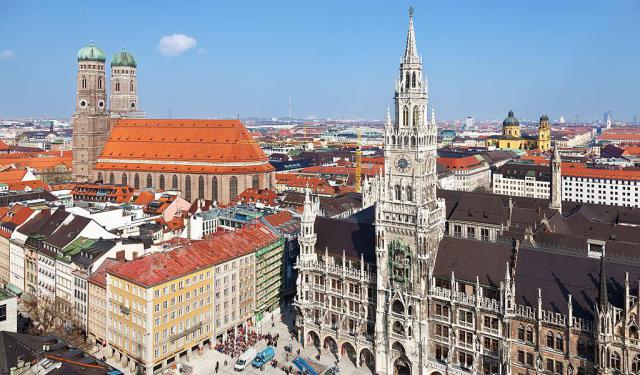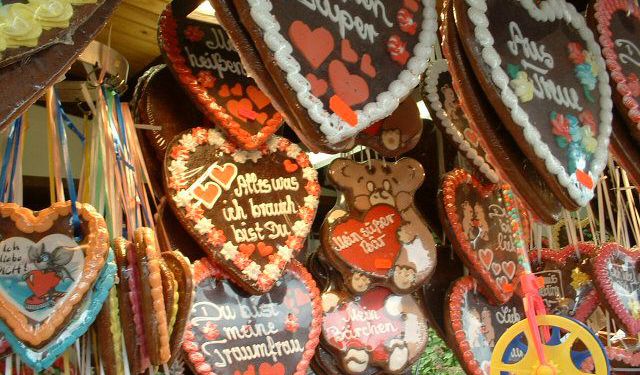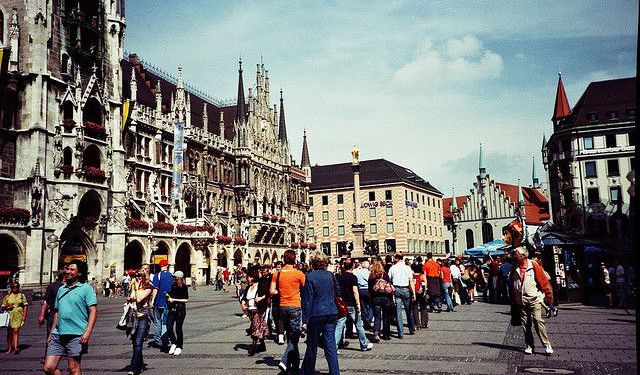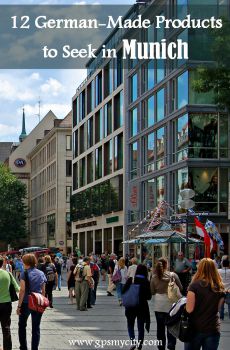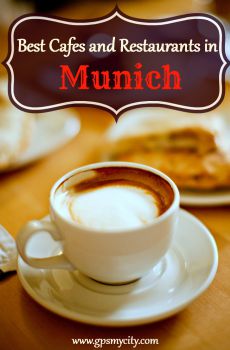Audio Guide: Third Reich Munich Walking Tour (Self Guided), Munich
In the early decades of the 20th century, Munich became the birthplace of one of history’s darkest political movements. Long before the world knew what was coming, Bavaria’s capital had already laid the groundwork for the rise of the National Socialist German Workers' Party-better known as the Nazi Party.
From 1933 to 1945, the Third Reich took hold of Germany under Adolf Hitler’s totalitarian regime. During that time, Munich wasn’t just another German city-it served as the organizational center of the Nazi movement. The so-called Führerbau, or “Leader’s Building,” housed the party’s headquarters and became a symbol of their growing power. The title “Führer,” of course, referred directly to Hitler, who dominated the party hierarchy and eventually ruled Germany with absolute authority.
Munich also set the stage for some of Hitler’s first political maneuvers. In 1919, at the Sternecker beer hall, he delivered his very first public speech for the German Workers' Party, the precursor to the Nazi Party. Not far away, the Hofbräuhaus beer hall was once a key venue for his inflammatory rhetoric and early party rallies. Hitler’s failed coup attempt was launched from there and ended near the Field Marshal’s Hall, which the Nazis later converted into a shrine for their fallen followers.
Other buildings played their part as well. The Old Town Hall served as a Nazi administrative center during the regime, overseeing local government operations and further entrenching the party’s grip on the city.
Today, some refer to this period as “Munich’s shame”-a reflection on how deeply the city was tied to the origins of a regime responsible for war, genocide, and mass suffering. While many of the sites from that era still stand, they now serve as somber reminders of what happens when ideology turns to extremism. As you explore these locations, let this self-guided walk be more than just a tour-let it be a reflection, a reckoning, and a quiet moment of respect for the lives lost and the lessons learned.
From 1933 to 1945, the Third Reich took hold of Germany under Adolf Hitler’s totalitarian regime. During that time, Munich wasn’t just another German city-it served as the organizational center of the Nazi movement. The so-called Führerbau, or “Leader’s Building,” housed the party’s headquarters and became a symbol of their growing power. The title “Führer,” of course, referred directly to Hitler, who dominated the party hierarchy and eventually ruled Germany with absolute authority.
Munich also set the stage for some of Hitler’s first political maneuvers. In 1919, at the Sternecker beer hall, he delivered his very first public speech for the German Workers' Party, the precursor to the Nazi Party. Not far away, the Hofbräuhaus beer hall was once a key venue for his inflammatory rhetoric and early party rallies. Hitler’s failed coup attempt was launched from there and ended near the Field Marshal’s Hall, which the Nazis later converted into a shrine for their fallen followers.
Other buildings played their part as well. The Old Town Hall served as a Nazi administrative center during the regime, overseeing local government operations and further entrenching the party’s grip on the city.
Today, some refer to this period as “Munich’s shame”-a reflection on how deeply the city was tied to the origins of a regime responsible for war, genocide, and mass suffering. While many of the sites from that era still stand, they now serve as somber reminders of what happens when ideology turns to extremism. As you explore these locations, let this self-guided walk be more than just a tour-let it be a reflection, a reckoning, and a quiet moment of respect for the lives lost and the lessons learned.
How it works: Download the app "GPSmyCity: Walks in 1K+ Cities" from Apple App Store or Google Play Store to your mobile phone or tablet. The app turns your mobile device into a personal tour guide and its built-in GPS navigation functions guide you from one tour stop to next. The app works offline, so no data plan is needed when traveling abroad.
Third Reich Munich Walking Tour Map
Guide Name: Third Reich Munich Walking Tour
Guide Location: Germany » Munich (See other walking tours in Munich)
Guide Type: Self-guided Walking Tour (Sightseeing)
# of Attractions: 6
Tour Duration: 2 Hour(s)
Travel Distance: 3.3 Km or 2.1 Miles
Author: DanaOffice
Sight(s) Featured in This Guide:
Guide Location: Germany » Munich (See other walking tours in Munich)
Guide Type: Self-guided Walking Tour (Sightseeing)
# of Attractions: 6
Tour Duration: 2 Hour(s)
Travel Distance: 3.3 Km or 2.1 Miles
Author: DanaOffice
Sight(s) Featured in This Guide:
- Fuhrerbau (Leader's Building)
- Feldherrnhalle (Field Marshall’s Hall)
- Hofbrauhaus Beer Hall
- Altes Rathaus (Old Town Hall)
- Sterneckerbräu (Sternecker Brewery)
- Hitler's Early Residence in Munich
1) Fuhrerbau (Leader's Building)
Tucked into Munich’s cityscape, the so-called Leader’s Building is one of the most historically loaded structures left from the Nazi era. Built between 1933 and 1937, it housed Adolf Hitler’s Munich office and served as a key administrative hub for the regime.
The architecture is textbook Third Reich: neoclassical, rigidly symmetrical, and designed to impress. Long colonnades, marble interiors, and an air of permanence were meant to radiate power. The building was part of Hitler’s broader plan to reshape Munich into the “Capital of the Movement,” marking the city’s role as the cradle of the Nazi Party.
But what seared this spot into history books was the 1938 Munich Agreement. On September 29th, British Prime Minister Neville Chamberlain, French Premier Édouard Daladier, Italy’s Benito Mussolini, and Hitler gathered here to sign a deal that allowed Germany to annex parts of Czechoslovakia. Chamberlain famously returned home proclaiming “peace for our time”-words that would soon be haunted by war.
During WWII, the building continued to host official functions. After 1945, the U.S. military took over, transforming the building into the Central Art Collecting Point, where stolen artworks were gathered, catalogued, and eventually returned to their rightful owners. Later, the space was given a new role as home to the University of Music and Performing Arts, which still uses it today.
Though not open to the public, Hitler’s office still exists behind its original oak door-frozen in time. The building now sits at a strange crossroads: once a symbol of authoritarian power, now reimagined as a place for education and artistic creation.
The architecture is textbook Third Reich: neoclassical, rigidly symmetrical, and designed to impress. Long colonnades, marble interiors, and an air of permanence were meant to radiate power. The building was part of Hitler’s broader plan to reshape Munich into the “Capital of the Movement,” marking the city’s role as the cradle of the Nazi Party.
But what seared this spot into history books was the 1938 Munich Agreement. On September 29th, British Prime Minister Neville Chamberlain, French Premier Édouard Daladier, Italy’s Benito Mussolini, and Hitler gathered here to sign a deal that allowed Germany to annex parts of Czechoslovakia. Chamberlain famously returned home proclaiming “peace for our time”-words that would soon be haunted by war.
During WWII, the building continued to host official functions. After 1945, the U.S. military took over, transforming the building into the Central Art Collecting Point, where stolen artworks were gathered, catalogued, and eventually returned to their rightful owners. Later, the space was given a new role as home to the University of Music and Performing Arts, which still uses it today.
Though not open to the public, Hitler’s office still exists behind its original oak door-frozen in time. The building now sits at a strange crossroads: once a symbol of authoritarian power, now reimagined as a place for education and artistic creation.
2) Feldherrnhalle (Field Marshall’s Hall)
The Field Marshal's Hall is a grand open-air loggia built to honor Bavaria’s military leaders and the soldiers who died in the Franco-Prussian War. Commissioned by King Ludwig I in the 1840s, it was constructed on the site of a former city gate. The design was inspired by Florence’s famous Loggia dei Lanzi, bringing a touch of Italian grandeur to Munich’s historic center.
Standing at the front are two imposing bronze statues commemorating key figures in Bavarian military history: Count Tilly, who played a major role during the Thirty Years’ War, and Count von Wrede, a marshal from the Napoleonic era. In 1882, a third sculpture was added at the center-this one celebrating the Bavarian army’s role in the Franco-Prussian War. As you approach, you’ll also spot two lion statues at the steps, crafted in 1906. One, mouth open, faces the Residenz Royal Palace; the other, with mouth closed, looks toward the nearby church.
Yet for many, the site is remembered most for the dramatic events of 1923. That year, during the failed Beer Hall Putsch, Adolf Hitler led around 2,000 followers in an attempted coup, marching toward the center of Munich in what he called a “people’s revolution.” They were met by the Bavarian police in front of this very loggia. A deadly confrontation followed-four officers and sixteen insurgents were killed. Hitler was arrested shortly after and imprisoned. A decade later, after coming to power, he elevated the failed revolt into a cornerstone of the Nazi cult.
Standing at the front are two imposing bronze statues commemorating key figures in Bavarian military history: Count Tilly, who played a major role during the Thirty Years’ War, and Count von Wrede, a marshal from the Napoleonic era. In 1882, a third sculpture was added at the center-this one celebrating the Bavarian army’s role in the Franco-Prussian War. As you approach, you’ll also spot two lion statues at the steps, crafted in 1906. One, mouth open, faces the Residenz Royal Palace; the other, with mouth closed, looks toward the nearby church.
Yet for many, the site is remembered most for the dramatic events of 1923. That year, during the failed Beer Hall Putsch, Adolf Hitler led around 2,000 followers in an attempted coup, marching toward the center of Munich in what he called a “people’s revolution.” They were met by the Bavarian police in front of this very loggia. A deadly confrontation followed-four officers and sixteen insurgents were killed. Hitler was arrested shortly after and imprisoned. A decade later, after coming to power, he elevated the failed revolt into a cornerstone of the Nazi cult.
3) Hofbrauhaus Beer Hall (must see)
Arguably the most famous ‘watering hole’ in Munich, this spot is the embodiment of Bavarian tradition and spirit. Its story began in 1589, founded as part of the Royal Brewery by Wilhelm V. Back then, it wasn’t even open to the public-reserved instead for royal use. That changed in 1828, when the doors were finally thrown open to everyone. Today, it's among the city’s most beloved gathering places, steeped in old-world charm.
On the ground floor, long tables fill the hall that can hold 1,000 drinkers while bands belt out folk tunes. The menu is full of Bavarian classics, and the atmosphere is pure celebration. Upstairs, a vaulted ceremonial hall can seat another 1,300 people, with additional side rooms for smaller gatherings. And when the weather’s warm, the beer garden becomes a favorite hangout-with its shady chestnut trees, bubbling fountain, and relaxed outdoor vibe. On a typical day, around 10,000 liters of beer are served here-that’s over 17,000 pints.
True to tradition, the beer follows the Bavarian Beer Purity Law of 1516, which allows only natural ingredients. That standard is still upheld across the city, and the brews here are no exception-crafted with care and full of flavor.
But not all of the building’s history is festive. On February 24, 1920, Adolf Hitler stood here to announce the official program of the then-fledgling Nazi Party. Just over a year later, on July 29, 1921, he was elected as the Party’s leader-right in this very hall. So while the beer house is rightly remembered for joy, music, and beer, it also witnessed one of the more sobering moments of 20th-century history.
On the ground floor, long tables fill the hall that can hold 1,000 drinkers while bands belt out folk tunes. The menu is full of Bavarian classics, and the atmosphere is pure celebration. Upstairs, a vaulted ceremonial hall can seat another 1,300 people, with additional side rooms for smaller gatherings. And when the weather’s warm, the beer garden becomes a favorite hangout-with its shady chestnut trees, bubbling fountain, and relaxed outdoor vibe. On a typical day, around 10,000 liters of beer are served here-that’s over 17,000 pints.
True to tradition, the beer follows the Bavarian Beer Purity Law of 1516, which allows only natural ingredients. That standard is still upheld across the city, and the brews here are no exception-crafted with care and full of flavor.
But not all of the building’s history is festive. On February 24, 1920, Adolf Hitler stood here to announce the official program of the then-fledgling Nazi Party. Just over a year later, on July 29, 1921, he was elected as the Party’s leader-right in this very hall. So while the beer house is rightly remembered for joy, music, and beer, it also witnessed one of the more sobering moments of 20th-century history.
4) Altes Rathaus (Old Town Hall)
Before the New Town Hall took over in 1874, the Old Town Hall was where Munich’s city government did its business. Unlike many buildings that were torn down to make way for the new structure, this one remained-preserved as a testament to the city’s commitment to restoration over replacement.
With its dove-grey façade, amber-tiled steeple, and delicate Gothic spires, the Hall captures the essence of its 15th-century origins-though what stands today isn’t an exact replica. Over time, additions like a baroque onion dome and later, an overly enthusiastic attempt at “regothification,” took the structure further from its medieval roots than what the current version reflects. Ironically, the faithful postwar reconstruction you see today may be closer to the spirit of the original than what existed before the Allied bombing.
The oldest surviving element is the 12th-century tower, once part of the city’s medieval fortifications. Today, it houses the Toy Museum, where you’ll find a charming collection of vintage toys-from antique train sets to miniature zoos-spread across four narrow floors connected by a spiral staircase. There's also a gift shop with hand-picked items that make for great souvenirs.
The ceremonial hall still retains its Gothic grandeur, with broad wooden barrel vaults and a frieze of 96 coats of arms lining one wall. Meanwhile, on the building’s side, there's a whimsical surprise: a bronze statue of Shakespeare’s Juliet, a gift from the city of Verona in the 1970s.
But the building also carries a darker legacy. In 1938, Nazi propaganda minister Joseph Goebbels delivered a speech here that triggered the “Night of Broken Glass.” That night of terror saw synagogues burned, Jewish businesses destroyed, and thousands arrested. It’s widely seen as the moment when Nazi anti-Semitic violence escalated into what became the Holocaust.
With its dove-grey façade, amber-tiled steeple, and delicate Gothic spires, the Hall captures the essence of its 15th-century origins-though what stands today isn’t an exact replica. Over time, additions like a baroque onion dome and later, an overly enthusiastic attempt at “regothification,” took the structure further from its medieval roots than what the current version reflects. Ironically, the faithful postwar reconstruction you see today may be closer to the spirit of the original than what existed before the Allied bombing.
The oldest surviving element is the 12th-century tower, once part of the city’s medieval fortifications. Today, it houses the Toy Museum, where you’ll find a charming collection of vintage toys-from antique train sets to miniature zoos-spread across four narrow floors connected by a spiral staircase. There's also a gift shop with hand-picked items that make for great souvenirs.
The ceremonial hall still retains its Gothic grandeur, with broad wooden barrel vaults and a frieze of 96 coats of arms lining one wall. Meanwhile, on the building’s side, there's a whimsical surprise: a bronze statue of Shakespeare’s Juliet, a gift from the city of Verona in the 1970s.
But the building also carries a darker legacy. In 1938, Nazi propaganda minister Joseph Goebbels delivered a speech here that triggered the “Night of Broken Glass.” That night of terror saw synagogues burned, Jewish businesses destroyed, and thousands arrested. It’s widely seen as the moment when Nazi anti-Semitic violence escalated into what became the Holocaust.
5) Sterneckerbräu (Sternecker Brewery)
The Sternecker building may look like just another spot in Munich’s old town, but it quietly holds one of the darker turning points in 20th-century history. Originally part of the city’s long-standing beer hall tradition, it gained far more notoriety for its role in the early formation of the Nazi Party.
Back in September 1919, a young Adolf Hitler, working as an army intelligence agent, showed up at a meeting of the German Workers’ Party-a small, fringe political group holding court in the beer hall. He challenged a speaker mid-session, and his intense rhetoric left an impression on the party’s founders, including Anton Drexler. Before long, they invited him to join. He accepted-and the Sternecker became ground zero in the origin story of his political ascent.
Years later, in 1933, after seizing power, the Nazis turned a room above the beer hall into a small museum, packed with artifacts from the party’s early days-photos, furniture, and documents curated to feed the myth. Somehow, the building survived the Allied bombings that flattened much of Munich. The museum, however, was shut down after the war, and the beer hall faded out of existence in the decades that followed.
Today, the structure still stands, now home to a retail shop. There’s no plaque, no sign, no marker of its historical weight. Unlike other Nazi-era sites that have been formally preserved or publicly contextualized, the Sternecker remains quietly anonymous-its past buried beneath the rhythms of modern commerce. Yet for those who know the story, this building was a silent witness to a moment when history took a dark turn.
Back in September 1919, a young Adolf Hitler, working as an army intelligence agent, showed up at a meeting of the German Workers’ Party-a small, fringe political group holding court in the beer hall. He challenged a speaker mid-session, and his intense rhetoric left an impression on the party’s founders, including Anton Drexler. Before long, they invited him to join. He accepted-and the Sternecker became ground zero in the origin story of his political ascent.
Years later, in 1933, after seizing power, the Nazis turned a room above the beer hall into a small museum, packed with artifacts from the party’s early days-photos, furniture, and documents curated to feed the myth. Somehow, the building survived the Allied bombings that flattened much of Munich. The museum, however, was shut down after the war, and the beer hall faded out of existence in the decades that followed.
Today, the structure still stands, now home to a retail shop. There’s no plaque, no sign, no marker of its historical weight. Unlike other Nazi-era sites that have been formally preserved or publicly contextualized, the Sternecker remains quietly anonymous-its past buried beneath the rhythms of modern commerce. Yet for those who know the story, this building was a silent witness to a moment when history took a dark turn.
6) Hitler's Early Residence in Munich
Adolf Hitler’s early residence in Munich played a significant role during the years when his political influence was taking shape. From May 1920 to October 1929, he lived in this third-floor flat-a period that saw him rise from fringe agitator to leader of the Nazi Party.
The building itself was well-situated: close enough to major meeting halls, yet far enough removed to offer a degree of privacy. During this time, Hitler wasn’t just living-he was strategizing. He worked on his autobiography, “My Struggle”, hosted party loyalists, and slowly built the organizational backbone of National Socialism from this very spot.
In the late 1920s, his half-niece, Geli Raubal, moved in. Their close and controversial relationship became the subject of intense speculation, ending in tragedy when Geli took her own life in 1931, after moving out. Her death left a lasting mark on Hitler.
After he relocated in 1929, the apartment faded into anonymity. Today, the building still stands, serving as a regular residential address with no plaque, no signage, no public trace of what once took place behind its doors. A quiet relic of a deeply consequential chapter.
The building itself was well-situated: close enough to major meeting halls, yet far enough removed to offer a degree of privacy. During this time, Hitler wasn’t just living-he was strategizing. He worked on his autobiography, “My Struggle”, hosted party loyalists, and slowly built the organizational backbone of National Socialism from this very spot.
In the late 1920s, his half-niece, Geli Raubal, moved in. Their close and controversial relationship became the subject of intense speculation, ending in tragedy when Geli took her own life in 1931, after moving out. Her death left a lasting mark on Hitler.
After he relocated in 1929, the apartment faded into anonymity. Today, the building still stands, serving as a regular residential address with no plaque, no signage, no public trace of what once took place behind its doors. A quiet relic of a deeply consequential chapter.
Walking Tours in Munich, Germany
Create Your Own Walk in Munich
Creating your own self-guided walk in Munich is easy and fun. Choose the city attractions that you want to see and a walk route map will be created just for you. You can even set your hotel as the start point of the walk.
Munich Introduction Walking Tour
Set along the banks of the River Isar, just north of the Bavarian Alps, Munich is a city steeped in history, where centuries-old buildings meet a rich array of cultural landmarks and modern-day energy.
The first recorded mention dates back to 1158. The name is believed to come from the Old and Middle High German word “munichen”, meaning “by the monks.” It refers to the Benedictine monks... view more
Tour Duration: 2 Hour(s)
Travel Distance: 2.5 Km or 1.6 Miles
The first recorded mention dates back to 1158. The name is believed to come from the Old and Middle High German word “munichen”, meaning “by the monks.” It refers to the Benedictine monks... view more
Tour Duration: 2 Hour(s)
Travel Distance: 2.5 Km or 1.6 Miles
Old Town Souvenir Shops
"Collect moments, not things," wise men say. In reference to travel, this may be interpreted as the prevalence of experiences and memories over material gains. Still, when it comes to travel mementos, albeit material they are, memories and experiences are primarily what these little (or not so little) tokens are all about.
And it would be a pity to leave Munich without bringing home... view more
Tour Duration: 1 Hour(s)
Travel Distance: 1.5 Km or 0.9 Miles
And it would be a pity to leave Munich without bringing home... view more
Tour Duration: 1 Hour(s)
Travel Distance: 1.5 Km or 0.9 Miles
Old Town Walking Tour
Munich’s Old Town, known as the Altstadt, unfolds across the western bank of the River Isar-a captivating blend of medieval charm, architectural brilliance, and deep cultural roots. As the historic heart of the Bavarian capital, it’s more than just a preserved district-it is is listed as a historical monument and is a living museum – “where the past harmonizes with the present in a grand... view more
Tour Duration: 2 Hour(s)
Travel Distance: 2.7 Km or 1.7 Miles
Tour Duration: 2 Hour(s)
Travel Distance: 2.7 Km or 1.7 Miles
Useful Travel Guides for Planning Your Trip
12 German-Made Things to Buy in Munich
The Bavarian capital Munich, much as the whole state of Bavaria, form an inseparable part of the German image, although a very unique part in its difference to the rest of the country, including the language. Bavarian beer occupies an important place in German heritage, from the infamous 1920s Beer...
Top 10 Cafes and Restaurants in Munich
While there are many restaurants and cafes in downtown Munich for a visitor to choose from, by far not all of them are truly worth visiting. Here's the solid list of quality cafes and restaurants that will add greatly to your Munich experience. Each restaurant and cafe featured here offers...
The Most Popular Cities
/ view all
